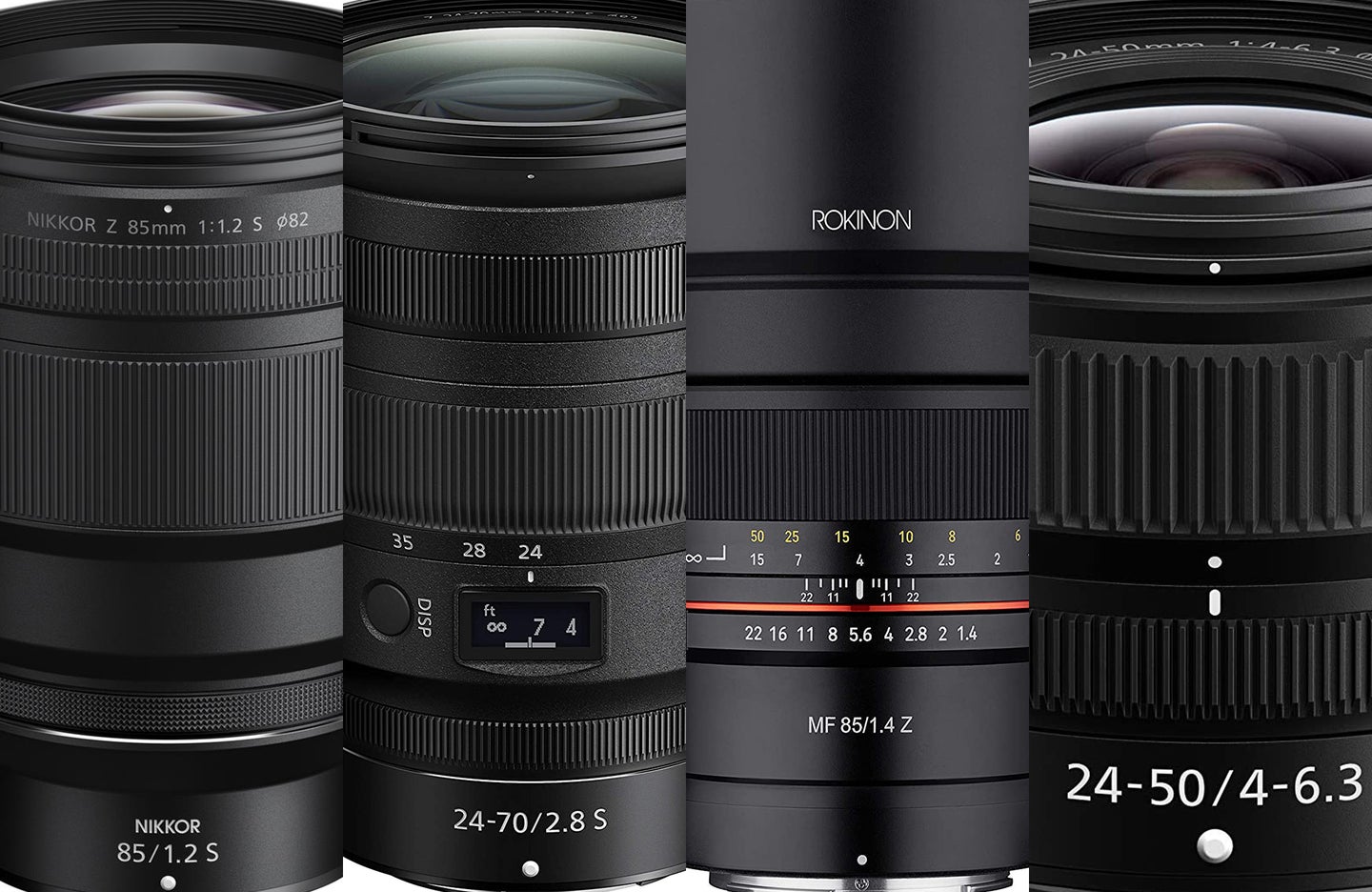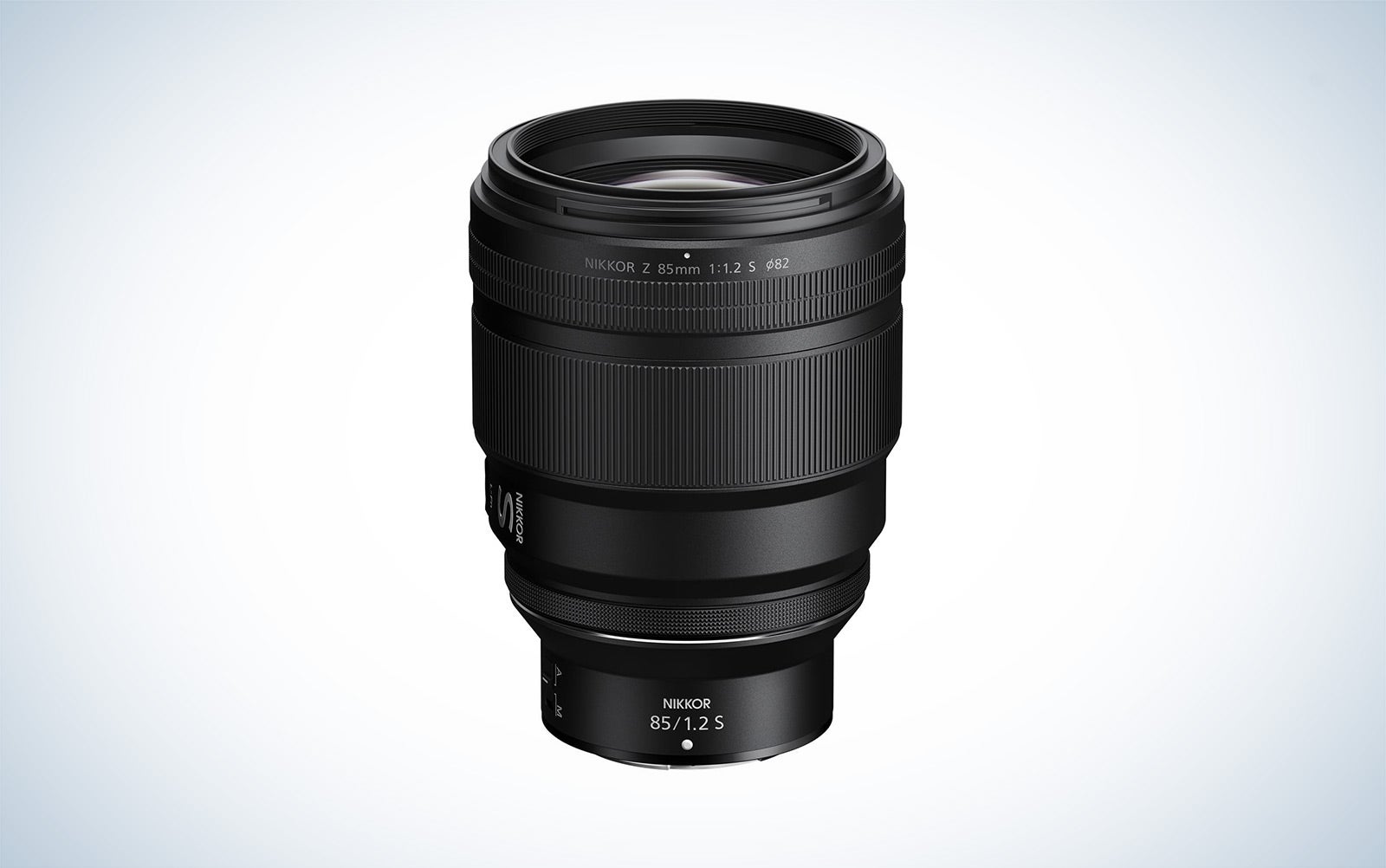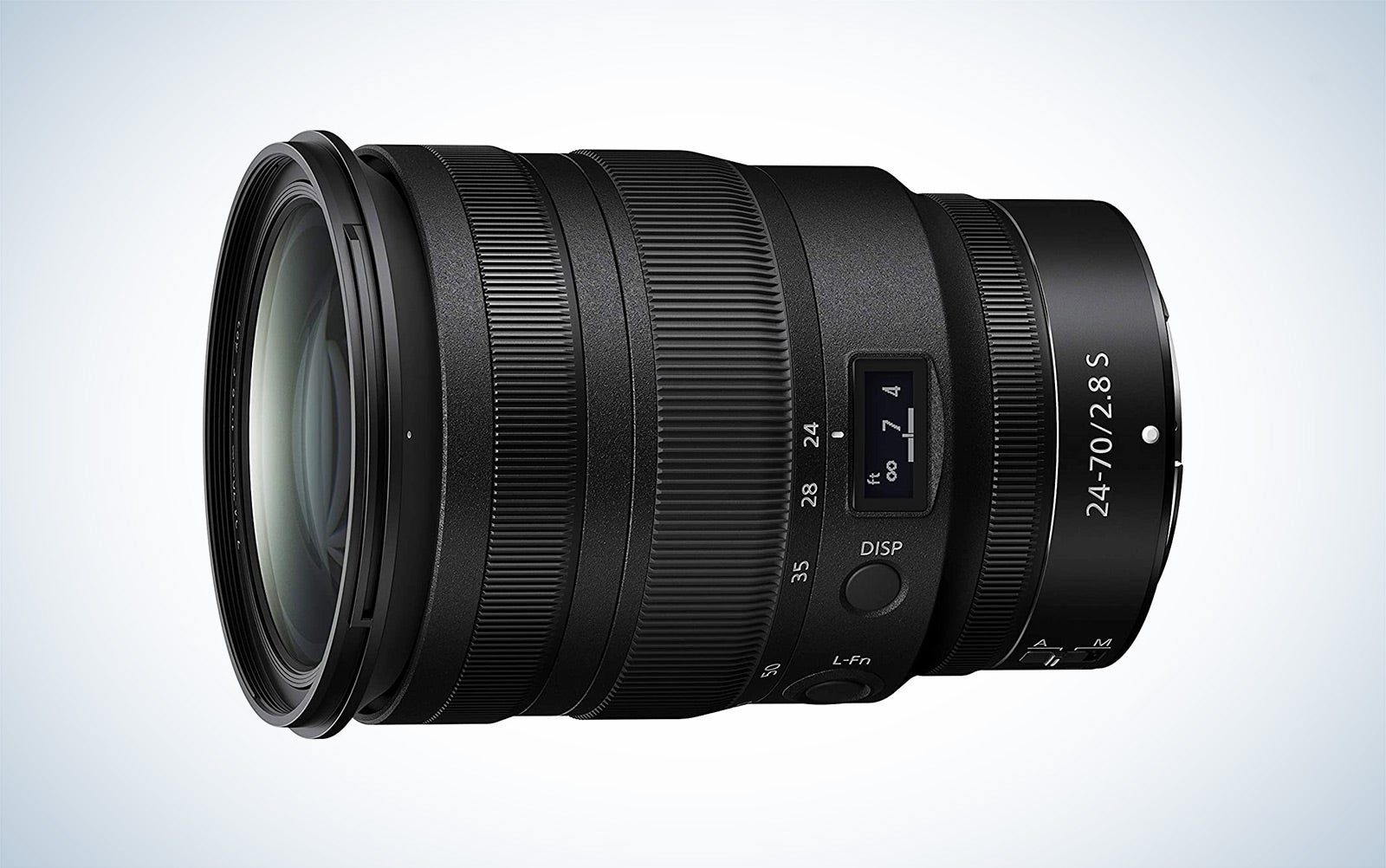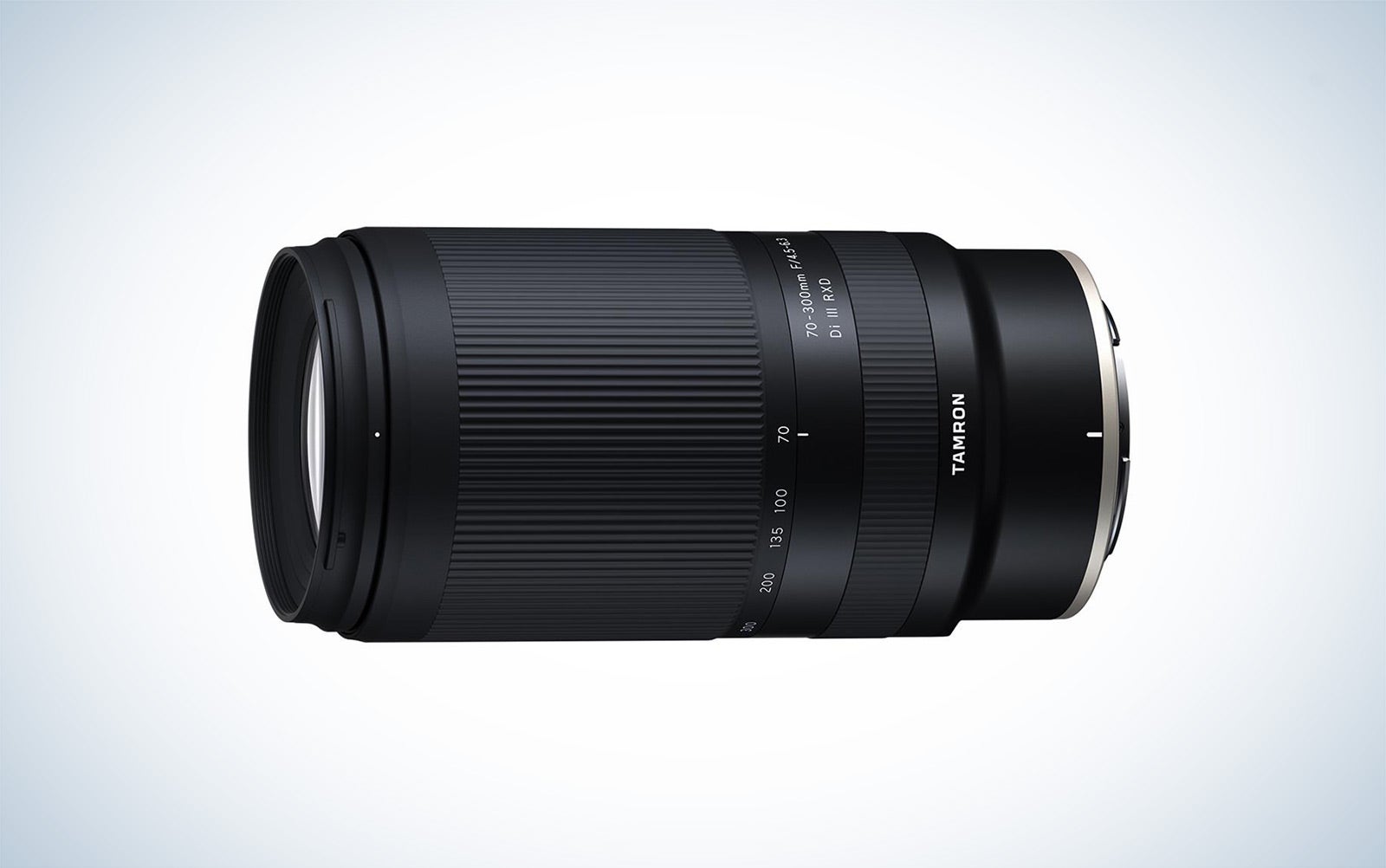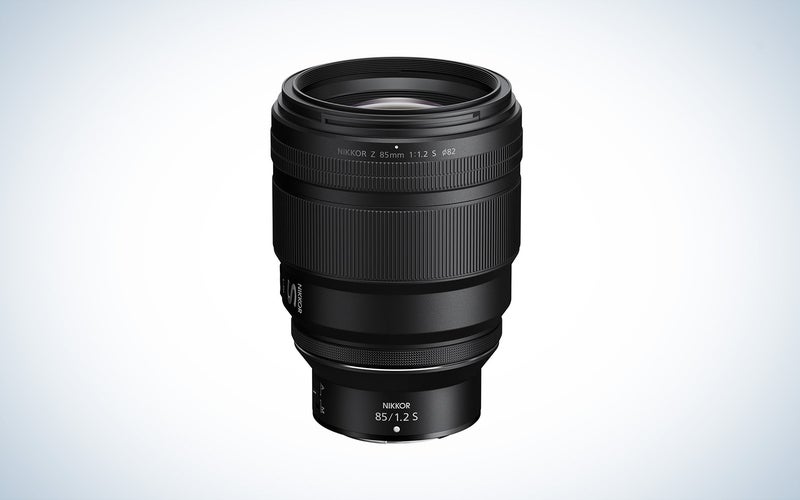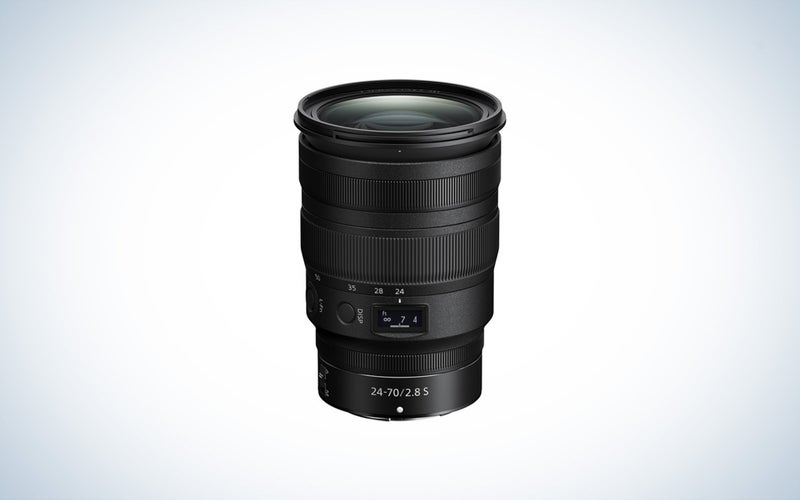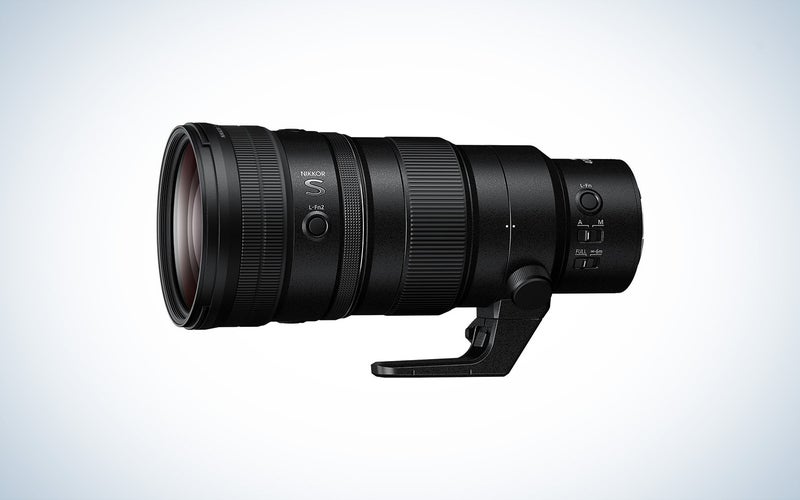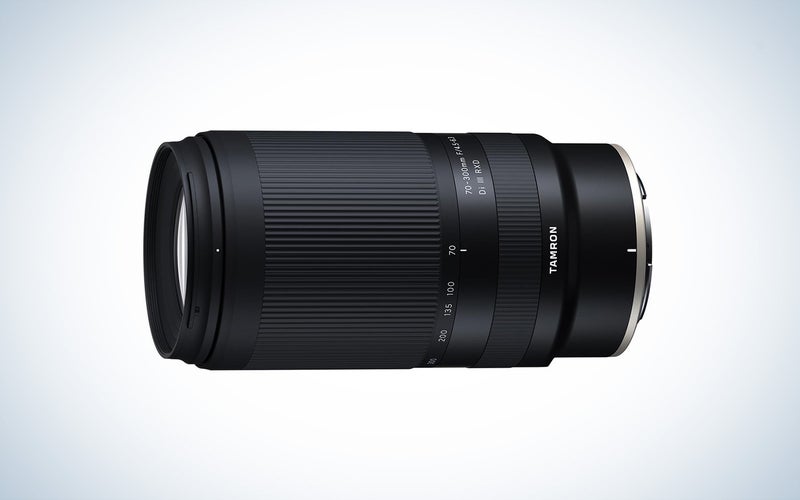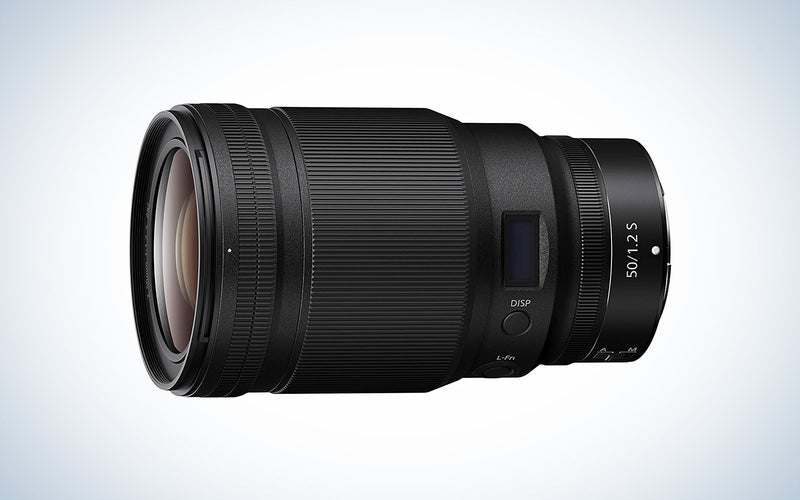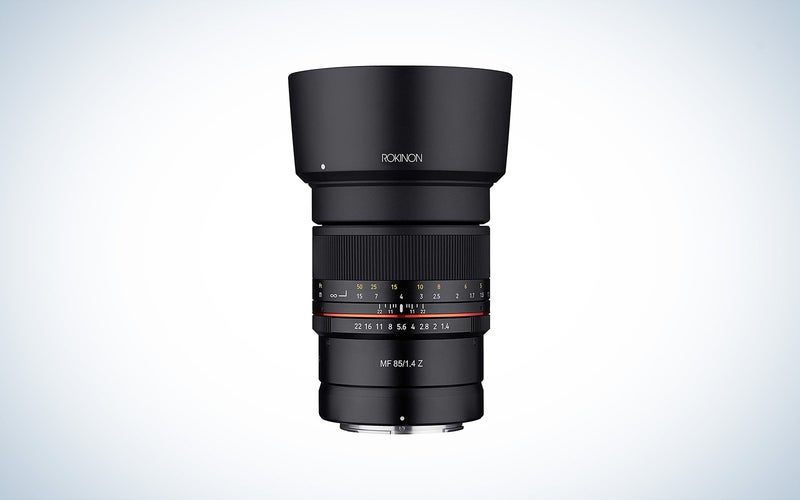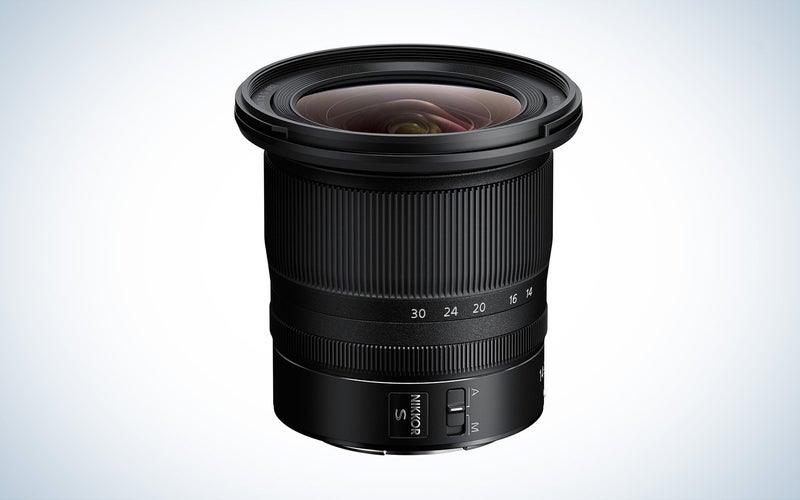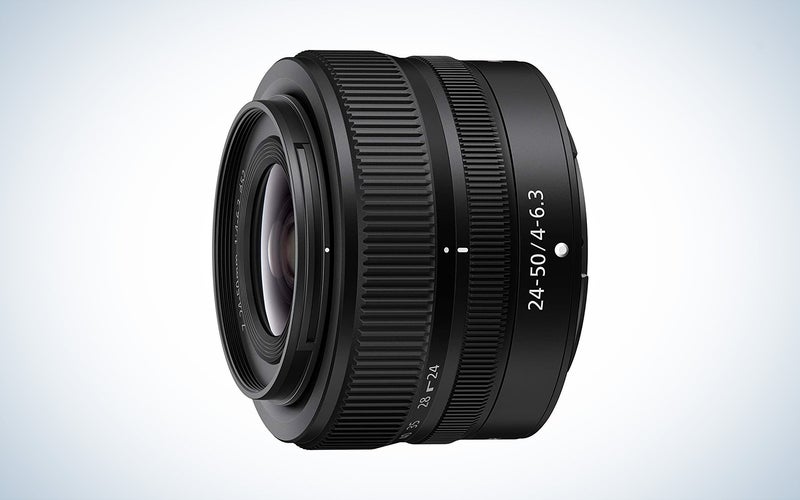We may earn revenue from the products available on this page and participate in affiliate programs. Learn more ›
Having a portrait lens (or a few) for Nikon is an important step in making your photos stand out and enhance your subjects. When shooting with a Nikon camera, there are a ton of excellent lenses that you can consider bringing to your shoot. Using native Nikon lenses ensures that your camera is performing at its best, but they do tend to be more expensive. Third-party lenses (made by brands that aren’t Nikon) are a good way to save some money as you build out your gear collection. Whether you are shooting with a Nikon DSLR or a mirrorless camera, the best portrait lenses for Nikon will help elevate your portrait work.
- Best overall: Nikon NIKKOR Z 85mm f/1.2 S
- Best standard zoom: Nikon NIKKOR Z 24-70mm f/2.8 S
- Best telephoto zoom: Nikon NIKKOR Z 70-200mm f/2.8 VR S
- Best budget telephoto zoom: Tamron 70-300mm f/4.5-6.3 Di III RXD
- Best prime: Nikon NIKKOR Z 50mm f/1.2 S
- Best budget prime: Rokinon 85mm f/1.4 Lens for Nikon Z
- Best wide-angle: Nikon NIKKOR Z 14-30mm f/4 S
- Best budget wide-angle: Nikon NIKKOR Z 24-50mm f/4-6.3
How we picked the best portrait lenses for Nikon
Different portraits call for different lenses, which is why we’ve selected a wide range of options for different portrait situations. We also aimed to choose lenses suitable for different budgets since not everyone needs or can afford a professionally-priced piece of glass. When selecting the lenses included here, we prioritized image quality above all, which includes factors such as sharpness, aberrations, distortion, and more. We also looked at additional lens features such as controls and handling, weatherproofing, and autofocus.
The best portrait lenses for Nikon: Reviews & recommendations
Portrait photography is a broad term that covers a wide range of situations and styles. The best portrait lenses for Nikon cover the gamut of headshot lenses to tools for environmental portraiture and everything in between.
Best overall: Nikon NIKKOR Z 85mm f/1.2 S
Nikon
Specs
- Lens mount: Z-mount, full-frame
- Aperture range: f/1.2 – f/16
- Image stabilization: No
- Filter size: 82 mm
- Minimum focus distance: 33.46 inches
- Weight: 2.6 pounds
- Dimensions: 4 x 5.6 inches
Pros
- Extremely sharp
- Fast f/1.2 aperture
- Smooth, attractive bokeh
- Weather-sealed
Cons
- Heavy
An 85mm prime is perhaps the quintessential portrait lens. The 85mm focal length provides flattering distortion for portraits and offers a nice working distance to put your subject at ease. They also typically feature fast apertures for beautiful background separation and bokeh, which is most certainly the case with this Nikon 85mm for its mirrorless cameras.
The NIKKOR Z 85mm offers a bright f/1.2 aperture, making it ideal for low-light conditions as well as getting plenty of separation between your subject and the background. It’s capable of razer-thin depth of field for dramatic images. To aid in that, this prime lens features a rounded 11-blade diaphragm, resulting in beautifully smooth bokeh. And this lens is incredibly sharp, so you’ll be able to get highly-detailed portraits, especially when paired with a high-resolution camera like the Z9.
Nikon’s mirrorless 85mm is also a fantastic video tool. It offers fast, accurate, and silent autofocus thanks to the two STM motors. And there’s essentially no focus breathing, meaning your videos will be smoother. At 2.6 pounds, the lens is heavy, but it is weather-sealed and worth the weight for the quality.
Best standard zoom: Nikon NIKKOR Z 24-70mm f/2.8 S
Nikon
Specs
- Lens mount: Z-mount, full-frame
- Aperture range: f/2.8 – f/22
- Image stabilization: No
- Filter size: 82 mm
- Minimum focus distance: 1.25 feet
- Weight: 1.7 pounds
- Dimensions: 3.5 x 4.96 – 6.15 inches
Pros
- Versatile focal length
- Relatively lightweight and compact
- Excellent image quality
- Useful OLED display
Cons
- Pricey
A quality 24-70mm lens is a true workhorse, capable of covering a variety of subjects and situations. The versatile focal length range of this lens makes it especially ideal for wedding photographers who need to cover a range of portrait types at any given moment. And Nikon’s Z-mount 24-70mm is a fantastic example of how good these lenses can be.
This lens offers stunning image quality with excellent sharpness. And there’s essentially no fringing or aberrations. Images from this 24-70mm lens are clear and highly detailed, making it a fantastic portrait tool. The bright f/2.8 aperture lends itself well to low-light situations, perfect for reception portraits. The bokeh is overall very nice, providing attractive backgrounds.
The NIKKOR 24-70mm f/2.8 S also is excellent in terms of handling. The lens features an OLED display on the top and allows you to quickly see important details such as focal length, aperture, or focus distance. And there’s a focus mode switch and a customizable L-Fn button. It’s fully weather-sealed, so you can shoot confidently in inclement weather. And it’s one of the lightest lenses of its class, making it easier to keep on your camera for those long wedding days.
Best telephoto zoom: Nikon NIKKOR Z 70-200mm f/2.8 VR S
Nikon
Specs
- Lens mount: Z-mount, full-frame
- Aperture range: f/2.8 – f/22
- Image stabilization: Yes
- Filter size: 77 mm
- Minimum focus distance: 1.64 feet
- Weight: 2.99 pounds
- Dimensions: 3.5 x 8.66 inches
Pros
- Offers image stabilization
- Fast and constant f/2.8 aperture
- Exceptionally sharp
- Fast and accurate autofocus
Cons
- Heavy
A 70-200mm telephoto lens is another one of those classic portrait lenses for Nikon, especially for wedding photographers. This versatile focal length is ideal for capturing the couple exchanging vows when you can’t get close, but also for shots like bridal portraits. Nikon’s mirrorless 70-200mm lens is one of the best in its class, with exceptional image quality across the board.
The lens comes with a pro-level price, but you get pro-level optics as a result. It’s extremely sharp, perhaps Nikon’s sharpest lens yet. That sharpness remains at every focal length and even when wide open, which is impressive. The lens shows very minimal distortion, vignetting, or aberrations. It also focuses quickly and accurately, even when working with moving subjects.
As with most of Nikon’s Z-mount lenses, the handling of the lens is excellent. It’s rugged and weather-sealed, so you can keep shooting no matter what the weather. The focus and zoom are all internal, keeping the balance of the lens consistent no matter what. And there are plenty of lens controls to make adjusting settings faster than going into camera menus. Overall it’s a spectacular lens that will be an asset in a range of portrait and wildlife photography situations.
Best budget telephoto zoom: Tamron 70-300mm f/4.5-6.3 Di III RXD
Tamron
Specs
- Lens mount: Z-mount, full-frame
- Aperture range: f/4.5 to f/6/3 – f/22 to 32
- Image stabilization: No
- Filter size: 67 mm
- Minimum focus distance: 31.5 inches
- Weight: 1.2 pounds
- Dimensions: 3 x 5.8 – 8.5 inches
Pros
- Lightweight and compact
- Good close focusing abilities
- Sharp
- Affordable
Cons
- Variable max aperture
- No stabilization
If you want that 70-200mm range but don’t want to spend a small fortune, Tamron’s offering is an excellent choice that is less than a quarter of the price of the Nikon 70-200mm. And it even gives you 100mm more reach, making it even better for wildlife photography or portraits that require distance between you and the subject.
Despite the bure budget-friendly price, Tamron’s telephoto zoom lens has a lot to offer. The autofocus is powered by an RXD stepping motor unit which results in fast, quiet, and accurate focusing. It’s weather-sealed and weighs only 1.2 pounds, which is more than a pound less than Nikon’s 70-200mm lens. And the overall sharpness is really impressive, with the exception of some edge softness when shooting wide open.
Of course, with the low price point, there must be some compromise. The f/4.5 max aperture isn’t all that bright, making low-light shooting more challenging. You also lose a stop of light when zooming in. And there is no in-lens stabilization. Luckily all of Nikon’s full-frame mirrorless cameras provide in-body image stabilization (IBIS), but you may still want to utilize a tripod when dealing with low-light conditions.
Best prime: Nikon NIKKOR Z 50mm f/1.2 S
Nikon
Specs
- Lens mount: Z-mount, full-frame
- Aperture range: f/1.2 – f/16
- Image stabilization: No
- Filter size: 82 mm
- Minimum focus distance: 1.5 feet
- Weight: 2.4 pounds
- Dimensions: 3.5 x 5.9 inches
Pros
- Fast maximum aperture
- Impressive image quality
- Plenty of lens controls
- Beautiful bokeh
Cons
- Bulky and heavy
A classic nifty-fifty is a must-have for portrait photographers. Even though it’s a prime lens, it’s incredibly versatile. The NIKKOR Z 50mm f/1.2 S fits the bill for an all-rounder, in part thanks to its bright f/1.2 aperture. It will make shooting in dark rooms or late evening light much easier thanks to that wide aperture.
The image quality of the mirrorless 50mm for Nikon is stunning. It offers high-resolution images when wide open but is even better stopped down to f/1.8. The rounded nine-blade diaphragm results in beautifully smooth bokeh. And the background separation, in general, is excellent, with smooth transitions to out-of-focus regions. This lens will help isolate your subject from the background, keeping them the focus of the shot.
With the fast aperture comes a hefty price tag and also a hefty lens size. It weighs 2.4 pounds and is 5.9 inches long. That is quite large for a 50mm prime. If you don’t mind losing a stop of light, Nikon’s 50mm f/1.8 S only weighs 14.64 ounces and is less than a third of the price of the f/1.2 version. The f/1.2 aperture is worth it for many portrait photographers, which is why we’ve picked it as one of our favorite prime portrait lenses for Nikon. But for general use, the f/1.8 will also perform extremely well.
Best budget prime: Rokinon 85mm f/1.4 Lens for Nikon Z
Rokinon
Specs
- Lens mount: Z-mount, full-frame
- Aperture range: f/1.4 – f/22
- Image stabilization: No
- Filter size: 72 mm
- Minimum focus distance: 3.61 feet
- Weight: 1.63 pounds
- Dimensions: 3.07 x 4.04 inches
Pros
- Fast maximum aperture
- Ideal portrait focal length
- Good sharpness
- Affordable
- Relatively compact and lightweight
Cons
- No aperture controls from the camera
- Manual focus only
If you are okay with doing away with any camera and lens communication, Rokinon’s 85mm f/1.4 lens for Nikon mirrorless cameras is an affordable yet quality option. But be aware that this lens only offers manual focus and aperture controls via the lens itself. You won’t be able to change your aperture on the camera at all and won’t be able to utilize subject tracking or any other autofocus features of your Nikon.
With that out of the way, the Rokinon 85mm is an excellent budget choice for portrait photographers willing to put in the work. It offers a fast f/1.4 aperture for good low-light performance. Overall it provides good sharpness, though you will want to stop it down slightly to get the most out of it. Distortion is minimal, and there’s very little vignetting as well.
Though it’s not fully weather-proof, there is a weather seal at the lens mount to give you a layer of protection should you get caught in the rain. It is relatively compact and lightweight for an 85mm, making it easier to carry around for a full day of shooting. The contrast is lower than other lenses, but it offers a slightly old-school, film-like look which we rather like anyway. There are tradeoffs with this Rokinon lens, for sure, but for the price, we think it’s worth it for many photographers.
Best wide-angle: Nikon NIKKOR Z 14-30mm f/4 S
Nikon
Specs
- Lens mount: Z-mount, full-frame
- Aperture range: f4 – f/22
- Image stabilization: No
- Filter size: 82 mm
- Minimum focus distance: 11.02 inches
- Weight: 1.07 pounds
- Dimensions: 3.5 x 3.35 – 4.49 inches
Pros
- Superb image quality
- Precise and quiet autofocus
- Good close focusing abilities
- Versatile focal length range
Cons
- f/4 aperture isn’t very fast
Wide-angle lenses aren’t typically the first thing people look for when shopping for portrait lenses for Nikon. But they are surprisingly versatile, even for portraiture. They allow for documenting large groups at events, capturing getting-ready shots in small rooms, and epic dance floor photos at receptions. This Nikon 14-30mm is an ideal range, offering an ultra-wide perspective with a much more modest, portrait-friendly 30mm as well.
The NIKKOR Z 14-30mm f/4 S is one of the sharpest wide-angle zoom lenses across any brand. You’ll be able to get some highly detailed portraits. On top of the high resolution, the lens offers fast and quiet autofocus, ideal for photographing in quiet scenarios. It can focus as close as 11.02 inches, which you may not want for portraits, but will come in handy for photographing detail shots at weddings.
The lens is relatively compact and lightweight, so you won’t mind keeping it on your camera while shooting all day. Like all Nikon S lenses, it’s a rugged lens with weather-sealing. The main downside of the lens is that the f/4 aperture isn’t all that fast. If you’d rather an f/2.8 aperture and don’t mind losing out on some focal length range, the NIKKOR Z 17-28mm f2.8 is your best bet. It isn’t as sharp as the 14-30mm, which is why it’s not our top choice for a wide-angle portrait lens for Nikon, but it still performs very well.
Best budget wide-angle: Nikon NIKKOR Z 24-50mm f/4-6.3
Nikon
Specs
- Lens mount: Z-mount, full-frame
- Aperture range: f/4 to 6.3 – f/22 to 36
- Image stabilization: No
- Filter size: 52 mm
- Minimum focus distance: 1.15 feet
- Weight: 6.88 ounces
- Dimensions: 2.89 x 2.01 – 2.94 inches
Pros
- Very compact and lightweight
- Affordable
- Silent autofocus
- Dust- and moisture-resistant design
Cons
- Aperture isn’t very bright
- Small zoom range
The NIKKOR Z 24-50mm f/4-5.6 is an affordable wide-angle lens, making it ideal for those wanting the wide-angle perspective at a more budget-friendly price. Despite the low price, it’s dust- and moisture-resistant, so you can use the lens in bad weather or dusty conditions without worrying as much.
Though not as sharp as more expensive lenses, the 24-50mm still provides good image quality, especially for the price. The autofocus is excellent, with silent and quick performance. It’s also a tiny lens, weighing only 6.88 ounces and measuring just 2.1 inches when the lens is stowed away.
There are some downsides to this budget portrait lens, however. The 24-50mm focal length doesn’t offer much range, especially when compared to similar lenses. And the maximum aperture varies from f/4 to f/6.3 as you zoom in, making it less than ideal for low-light situations. But the compact size and low price make this a worthwhile travel portrait lens for Nikon cameras.
Even more portrait lenses for Nikon that we love:
An ultra-fast wide-angle prime: Nikon NIKKOR Z 35mm f/1.8 S
This Nikon 35mm prime offers an f/1.8 aperture for beautiful bokeh, nine aperture blades, and an ultra-quiet stepping motor for silent focusing. The 5-Axis Dual detect optical VR allows for smooth stabilization. 35mm offers a slightly wider angle of view and is an incredibly versatile focal length. This is one of the best Nikon lenses for environmental portraits.
A more affordable standard zoom: Nikon NIKKOR Z 28-75mm f/2.8
While the NIKKOR Z 24-70mm f/2.8 S is a stunner, it also comes at a fairly stunning price. The NIKKOR 28-75mm offers a slightly different focal length range but is roughly a thousand dollars cheaper. You still get a fast f/2.8 aperture for good low-light performance and attractive bokeh. And it provides overall excellent image quality for beautiful portraits.
A dramatic ultra-wide: Nikon NIKKOR Z 14-24mm f/2.8 S
If you want to go all in on ultra-wide portraiture, the NIKKOR 14-24mm is the best of the best. Carrying on the tradition of Nikon’s legendary F-mount version of this focal length, it offers exceptional sharpness. It also provides beautiful bokeh, which is unique for an ultra-wide angle lens. You’ll be able to creat some truly unique and dramatic portraits with this beast of a lens.
A classic portrait lens for Nikon DSLRs: Nikon AF-S FX NIKKOR 85mm f/1.4G
An 85mm prime is typically regarded as the best lens for shooting portraits because of the flattering perspective that it produces. The Nikon AF S NIKKOR is designed to be used with Nikon’s DSLR cameras. It has a fast f/1.4 and nine-blade aperture for beautiful bokeh. It has a silent wave motor for quiet autofocusing and Nano Crystal Coat to reduce ghosting and flare to create sharper images. Picking up a refurbished one—rather than buying new—will help you save some dollars on this classic portrait lens.
The best 50mm lens for Nikon DSLRs: Nikon AF-S Nikkor 50mm f/1.8G
The beloved “nifty fifty” is a lens that every photographer should have in their camera gear kit. This 50mm lens is one of the cheapest native Nikon lenses. It Is a great option for shooting waist-up or full-length portraits. This camera lens is lightweight and has Nikon’s silent wave motor for quiet autofocusing. Plus, it has a super integrated coating to avoid smudges on the front element of the lens.
Things to consider before buying portrait lenses for Nikon
Camera mount
When shopping for the best portrait lenses for Nikon, it’s important to make sure that the lens will work with your camera body. Nikon’s mirrorless cameras use a different lens mount than DSLRs, so you won’t be able to use F-mount lenses on Z-mount cameras unless you get an adapter. There is no adapter going the other way, so you won’t be able to use Z-mount lenses on Nikon DSLRs.
If you are shooting with Nikon’s mirrorless Z camera system, you’ll mostly be stuck with Nikon lenses for the time being. Unfortunately, third-party lenses for Nikon Z-mount have been slow to come about, so there aren’t many options at this point. But, as mentioned, you can use your Nikon DSLR lenses on your mirrorless camera with an adapter, which can save you some money.
If you are a DSLR shooter and looking to save a bit of money, exploring some third-party lenses made by other companies is a more viable option. The F-mount system has been around for much longer, giving other lens companies time to engineer glass to work well with the cameras.
Prime or zoom
When shooting portraits, a fixed-focal-length lens—also called a prime lens—is an excellent tool to have in your gear kit. Prime lenses typically have much faster apertures than zoom lenses. This means they work great in low-light situations and have the ability to create separation between your subject and the background with beautiful bokeh. Prime lenses can also save you some money when compared to the prices of zoom lenses, especially those that offer fast apertures.
Zoom lenses, on the other hand, offer more versatility. Instead of needing to change lenses or move your body to get a different perspective, you can simply turn the lens to zoom in or out. But they can get extremely pricey and may not provide as fast of apertures. Which is best for you depends on your shooting style and priorities in a lens.
Focal length
Typically speaking, telephoto lenses are the preferred choice for portraits. Even more specifically, 85mm is often considered to be the golden standard when it comes to shooting portraits. The 85mm focal length lets the photographer be farther away from their subject and capture headshot-style portraits with dramatic background blur.
If you are interested in shooting full-body or waist-up portraits, a lens with a slightly wider field of view is a good choice. Shorter lenses, such as 35mm, 45mm, or 50mm, mean you have to be closer to your subject, but they also allow you to capture more of the surrounding environment. As a result, 35mm or 50mm are excellent for environmental portraits or street portraits.
Typically speaking, you’ll want to avoid anything much wider than 35mm, though. A wider field of view will begin to distort your portrait subject in unflattering ways. You can use this to your advantage for creative portraiture, and sometimes an ultra-wide angle is necessary for large group portraits. But for most portrait situations, you’ll want to stick to roughly 35mm and up.
FAQs
Q: Which is better for portraits—50mm or 85mm?
Both of these focal lengths are good for shooting portraits. It ultimately comes down to what you’d like to capture in the picture. An 85mm lens is typically considered a classic portrait lens. It allows the photographer to be farther away from their subject and gives a very flattering field of view. A 50mm lens means you have to be closer to your subjects as you shoot, or you’ll end up with more of the setting in the photo. The wider field of view means it’s a great choice for environmental portraits. A 50mm lens is typically more lightweight and cheaper too, which are advantages.
Q: What Nikon lenses do professional photographers use?
Professional photographers who shoot with Nikon cameras will have a variety of lenses that they like to shoot with. These vary depending on their style and subject matter. But a 24-70mm and 70-200mm can be found in the gear collection of most professionals. They typically also have a few fixed-focal-length primes, although what ones depend on what they are shooting. Photojournalists often favor 35mm or 50mm lenses, while someone who shoots in a studio would likely prefer an 85mm prime.
Q: What lenses do wedding photographers use?
Photographing a wedding is all about flexibility, so most wedding photographers arrive at the job with a variety of lenses. A 24-70mm lens is great for covering the ceremony and the reception. A macro lens is the best way to capture small details like the bride and groom’s rings. A 35mm fast prime is great for capturing candid moments of the guests on the dance floor when the lighting can be tricky. And an 85mm prime is a beautiful option for capturing bridal portraits.
Final thoughts on the best portrait lenses for Nikon
- Best overall: Nikon NIKKOR Z 85mm f/1.2 S
- Best standard zoom: Nikon NIKKOR Z 24-70mm f/2.8 S
- Best telephoto zoom: Nikon NIKKOR Z 70-200mm f/2.8 VR S
- Best budget telephoto zoom: Tamron 70-300mm f/4.5-6.3 Di III RXD
- Best prime: Nikon NIKKOR Z 50mm f/1.2 S
- Best budget prime: Rokinon 85mm f/1.4 Lens for Nikon Z
- Best wide-angle: Nikon NIKKOR Z 14-30mm f/4 S
- Best budget wide-angle: Nikon NIKKOR Z 24-50mm f/4-6.3
Portrait photography includes a vast range of portrait types and situations. Even wedding photography alone can involve a wide variety of portraits, including head-shot like bridal portraits, large group portraits, and candid environmental portraits on the dance floor. Each of these situations calls for a different focal length. Because of this, our picks for the best portrait lenses for Nikon cover the full spectrum of what portrait photography may throw at you. Which is best for you depends on what type of portraits you plan on shooting and what your personal style is.
Why trust us
PopPhoto has a long history of delivering the opinions of some of the sharpest and most prolific camera dorks the world has to offer. Since 1937, we’ve been reviewing cameras, providing wisdom from well-known photographers, and generally just nerding out about all that goes into making great pictures. Our current crop of writers and editors have decades of professional photography and camera writing experience among them. Collectively, we’ve probably shot with just about every camera and lens combo you can imagine—as well as some obscure stuff you may not even know about. Remember the Casio Tryx folding camera? PopPhoto does.
We also get that buying a camera is a big decision, which is why we’re dedicated to helping folks choose the right one (or, in our case “ones”) for their needs. Case in point: Handing over top dollar for an expensive rig may leave you unsatisfied if it doesn’t fit your preferred shooting style. Sure, a $6,000 sports-oriented DSLR can capture landscapes, but do you really need to do it at 30 frames-per-second? No, you don’t.
